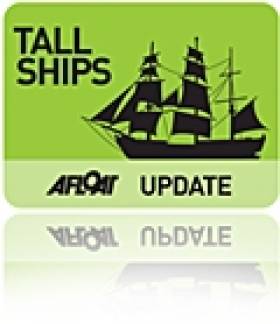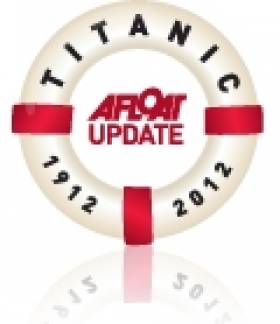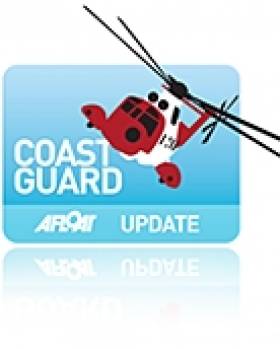Displaying items by tag: wreck
Famous United States Revenue Cutter Wreck is Found off Nova Scotia
After decades of searching, researchers from the U.S. National Oceanic and Atmospheric Administration and Coast Guard have located the shipwreck of the former U.S. Revenue Cutter, Bear.
The wreck of the Bear, which was lost at sea in 1963, is about 90 miles south of Cape Sable in Nova Scotia.
It was considered an amazing coincidence when the wreck was one of two targets initially located during an expedition two years by the current Coastguard cutter, also named Bear and which it was decided to explore further by USCG and NOAA teams this year by the larger and better equipped USCG's ocean-going buoy tender, Sycamore, with an advanced remotely operated vehicle (ROV) equipped with high-resolution underwater video cameras to to document the "unidentified wreck".
The team was able to collect evidence to positively identify the wreck.
Considered one of the most historically significant ships in U.S. and Coast Guard history, USRC Bear was built in Scotland in 1874 and purchased by the U.S. government in 1884.It was originally put into service by the U.S. Navy during the Arctic search for the Greely Expedition, where she earned her initial fame as the vessel that rescued the few survivors of that expedition. In 1885, Bear was transferred from the Treasury Department for service in the Arctic as a Revenue Cutter, where she patrolled for 41 years. After serving in the Greenland Patrols during World War II, the Bear was decommissioned in 1944 and was lost at sea while being towed to Philadelphia by a private party in 1963.
Researchers have been searching for the Bear since 1979. In 2007, a search was coordinated by the U.S. Navy but was ultimately unsuccessful. In recent years, NOAA and the U.S. Coast Guard have teamed up with other partners to locate the wreck site. The U.S. Revenue Cutter Service was established by Congress in 1790, operating under the Department of Treasury and later merged with the U.S. Life-Saving Service to form the United States Coast Guard.
Thieves Raid Astrid Wreck Under Cover Of Darkness
#Astrid - The ship's bell and compass are among the items stolen in a dastardly raid on the wreck of the tall ship Astrid near Kinsale, as The Irish Times reports.
Owner of the near-century-old brig Pieter De Kam said that while he is "eternally grateful to the Irish people" for the rescue of all 30 crew on board when the ship struck rocks last Wednesday (24 July), he is "not grateful to whatever Irish people have gone aboard my ship and stolen my compass, my bell and my binnacle".
Breaking the exclusion zone set up around the tall ship - which went down after striking rocks and taking on water in strong winds and heavy seas while taking part in The Gathering Cruise - it appears the thieves slipped in by nightfall at low tide last Friday night (26 July) to grab their ill-gotten loot.
Though the 42-metre sail training vessel remains mostly intact, despite her ordeal, in the water near the Sovereign Islands off Ballymacus Point, it is unlikely that she will sail again due to the severity of damage to her hull.
Titanic As She's Never Been Seen Before
#TITANIC - Next month's edition of National Geographic magazine features startling images with the first ever complete views of the wreck of the Titanic.
The large-scale panoramas were produced by combining "thousands of high-resolution images" of the wreck on the North Atlantic sea floor, according to the Guardian - which has a sample gallery of the Titanic as it is today HERE.
Search for Glandore Fishermen to be Wound Down
#NEWS UPDATE - The search for two fishermen still missing after their boat went down off West Cork nearly three weeks ago will be wound down next week, The Irish Times reports.
Search teams have been combing the area for any trace of Michael Hayes (35), skipper of the Tit Bonhomme, and crewman Said Mohammed (23) after the fishing vessel ran aground in rough seas near Adam's Rock, at the mouth of Glandore Harbour, on Sunday 15 January.
The bodies of Kevin Kershaw (21), Attia Shaban (26) and Wael Mohammed (35) were recovered in the days and weeks following the tragedy. Only one of the six-person crew - 43-year-old Abdul Mohammed – is confirmed to have survived.
As previously reported on Afloat.ie, last weekend saw more than 90 divers embark on an extensive search of the wreck site and the Glandore bay area, with hundreds more volunteers searching the coastline and on land.
Titanic Artifacts a Snap - at $189 Million!
#TITANIC - The Titanic is for sale - if you have a spare $189 million to spend, according to the Los Angeles Times.
The single-lot auction, which will take place in April on the 100th anniversary of the Belfast-built ocean liner's tragic demise, includes more than 5,000 items salvaged from the wreck, from gold coins and clothing to parts of the ship's hull itself.
But casual buyers need not apply, as aside from the multi-million-dollar outlay, the prospective purchases must also take on stewardship over the collection, preserving it for future generations and exhibiting parts of it to the public.
Arlan Ettinger, president of Guernsey's Auctioneers & Brokers in New York, commented: "It's like getting a puppy. When you bring it home, you don't think of all the responsibilities and the time and investment that will be required... But it takes great care."
Images of the items up for auction are available HERE.
Exclusion Zone Set Up Around Wreck of Fishing Vessel 'Tit Bonhomme'
#GLANDORE TRAWLER – In the interest of safety and to facilitate any search and recovery operations in the vicinity of the sunken vessel the F.V. TIT BONHOMME, the Department of Transport, Tourism and Sport has set up an exclusion zone has been created around the vicinity of the vessel.
Divers are expected to resume the search for five missing fishermen from the vessel this morning.
The vessel lies between Adam and Eve Islands in the approaches to Glandore Harbour, County Cork.
Only vessels and persons authorised by the Irish Coast Guard (IRCG) are permitted to enter this area, which lies within a 200 metre radius, centred on the wreck in approximate position:
51° 32'.4 N, 009° 06'.1 W.
Accordingly, for safety reasons, all other vessels in the vicinity are requested to keep clear of the exclusion zone and give this area a wide berth.
The exclusion zone will continue until further notice.
IRCG may be contacted at Valentia Marine Rescue Sub-Centre, tel: +353 (0)66 9476109.
Spanish Armada Wreck Discovered Off Donegal
RTÉ News reports that underwater archaeologists may have discovered a sunken ship from the Spanish Armada off the Donegal coast.
State funding has already been announced for an excavation of the wreck, which lies in shallow water at Rutland, near Burtonport.
Evidence suggests that the vessel is from the 16th century and was part of the 1588 expedition.
Minister for Arts, Heritage and the Gaeltacht Jimmy Deenihan described the discovery as "a major find of significance" to the world's historical and archaeological communities, adding that it could give greater "insight into life on board and the reality of the military and naval resources available to the Armada campaign".
RTÉ News has more on the story, including images and video, HERE.
GardaI Investigate U-boat Looting in Cork
Cork gardaí are investigating the looting of items from a First World War U-boat recently discovered off Roches Point.
The Irish Times reports that the submarine also appears to have been damaged by the illegal salvagers.
A spokesperson for the underwater archaeology unit of the Department of Arts, Heritage and the Gaeltacht confirmed that reports had come in from divers regarding disturbance of the wreck site - noting attempts to remove parts of the structure, and details of human remains.
Divers with the unit were expected to assess the site as soon as weather permits.
Items believed to have been taken include sailor's attire belonging to the crew of the 49-metre German vessel UC-42, which sank in 1917. The German embassy has indicated its "legitimate interest" in the preservation of the wreck.
The Irish Times has more on the story HERE.
Dive Ireland takes place this Weekend
CFT who are the national governing body for sports diving in Ireland will hold it's AGM and National Dive Conference at this event.
Some of the speakers include the following:
Jack Ingle Kit configuration
Barry McGill Deep wreck diving off the Donegal Coast
Nigel Motyer Underwater photographer
Tim Carey & Eoin Mc Garry Dive expedition to Asgard II in 2010
Ken O'Sullivan Irish ocean wildlife series Showing January 23rd TG4
Shane McArdle Sports Partnership and what it could mean for CFT clubs
More details and timetable HERE
Historic Lecture on the Easter Rising Vessel, The Aud
Embedded in the history of Ireland, the events which occurred in April 1916 place Roger Casement and his famous gun running ship in the annals of Irish history. She lies broken, in a depth 34 metres in Cork Harbour. Much of the cargo of 20,000 guns and 1,000,000 rounds ammunitions still remain writes Timmy Carey. The ship was scuttled by her captain Karl Spindler rather than hand the cargo to the British. This would be the only German naval surface ship to enter Irish waters during World War 1. The wreck was depth charged on a number of occasions to make sure that the weapons were scattered and made unrecoverable by rebel forces and to prevent submarines using the wreck as cover. The rifles and much of the ammunition originated in Russia. They were captured as a result of the rout of Russian forces at the battle of Tannenburg in 1914.
This coming Friday night Blackwater Sub Aqua Club in Fermoy will host a lecture on the Aud by author Xander Clayton. Xander is a researcher of Modern Irish history and is the leading authority on the Casement Ship. He has made a detailed study of the ship and her 22 man crew over the past quarter century, culminating with the publication of the book "AUD" in 2007. He now lives in Ireland and the second edition of his book is due for imminent publication. The lecture will start at 20:00 and is free of charge. The venue is Blackwater Sub Aqua Clubhouse, Rathealy Road, Fermoy. For further information contact Matthew Culotty 087-8217069.

Xander Clayton author of the book "Aud"

An image of the Aud ship before she was scuttled at the entrance to Cork harbour where she lies today

Karl Spindler the German captain of the Aud






































































